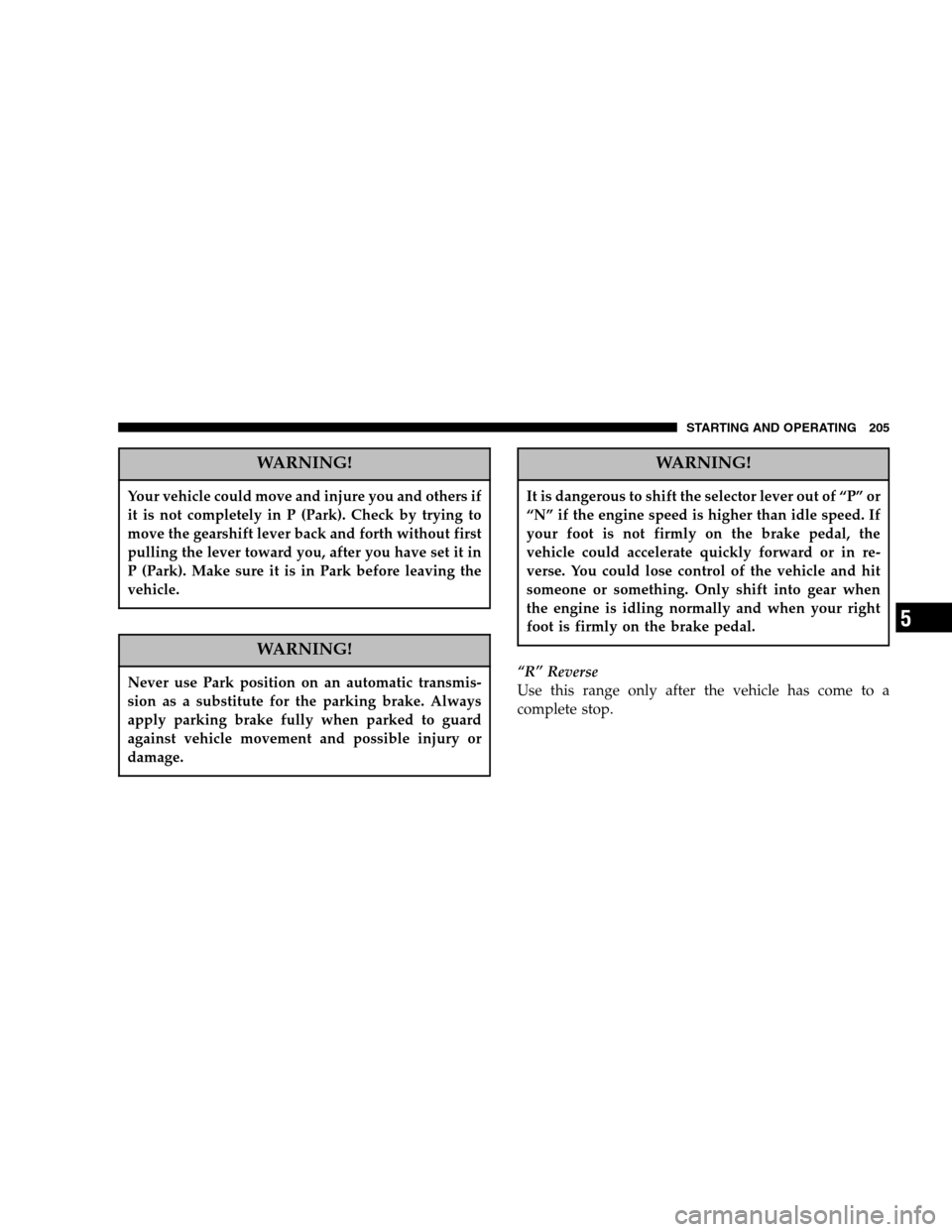Page 201 of 408

STARTING PROCEDURES
The starter should not be operated for more than 15
second intervals. Waiting a few seconds between such
intervals will protect the starter from overheating.
Manual Transmission
Apply the parking brake, place the gearshift control lever
in NEUTRAL and depress clutch pedal to the floor before
starting the vehicle. This vehicle is equipped with a
clutch interlocking ignition system. It will not start unless
the clutch is depressed.
Automatic Transmission
Start the engine with the shift lever in NEUTRAL or
PARK position. Apply the brake before shifting to any
driving range.
WARNING!
Do not attempt to push or tow your vehicle to get it
started. Vehicles equipped with an automatic trans-
mission cannot be started this way. Unburned fuel
could enter the catalytic converter and once the
engine has started, ignite and damage the converter
and vehicle. If the vehicle has a discharged battery,
booster cables may be used to obtain a start from a
booster battery or the battery in another vehicle. This
type of start can be dangerous if done improperly.
See section 6 of this manual for the proper jump
starting procedures and follow them carefully.
STARTING AND OPERATING 201
5
Page 204 of 408

WARNING!
Remember to disconnect the cord before driving.
Damage to the 110-115 volt electrical cord could
cause electrocution.
AUTOMATIC TRANSMISSION
Automatic Transmission
The electronic PRNDL on the instrument cluster indicates
the transmission gear selected. The selector lever is
mounted on the right side of the steering column. To
drive, move the selector lever from Park or Neutral to the
desired drive position. Pull selector lever toward you
when shifting into Reverse, Second, First or Park, or
when shifting out of Park.
Brake/Transmission Interlock System
This system prevents you from moving the gear shift out
of Park and into any gear unless the brake pedal is
pressed. This system is active only while the ignition
switch is in the ON position. Always depress the brake
pedal first, before moving the gear selector out of PARK.
Gear Ranges
DO NOT race the engine when shifting from Park or
Neutral position into another gear range.
“P” Park
Supplements parking brake by locking the transmission.
Engine can be started in this range. Never use Park while
vehicle is in motion. Apply parking brake when leaving
vehicle in this range. Always apply parking brake first,
then place selector in Park position.
204 STARTING AND OPERATING
Page 205 of 408

WARNING!
Your vehicle could move and injure you and others if
it is not completely in P (Park). Check by trying to
move the gearshift lever back and forth without first
pulling the lever toward you, after you have set it in
P (Park). Make sure it is in Park before leaving the
vehicle.
WARNING!
Never use Park position on an automatic transmis-
sion as a substitute for the parking brake. Always
apply parking brake fully when parked to guard
against vehicle movement and possible injury or
damage.
WARNING!
It is dangerous to shift the selector lever out of “P” or
“N” if the engine speed is higher than idle speed. If
your foot is not firmly on the brake pedal, the
vehicle could accelerate quickly forward or in re-
verse. You could lose control of the vehicle and hit
someone or something. Only shift into gear when
the engine is idling normally and when your right
foot is firmly on the brake pedal.
“R” Reverse
Use this range only after the vehicle has come to a
complete stop.
STARTING AND OPERATING 205
5
Page 206 of 408

“N” Neutral
Shift to Neutral when vehicle is standing for prolonged
periods with engine running. Engine may be started in
this range. Set the parking brake if you must leave the
vehicle.
“D” Drive
For most city and highway driving.
“2” Second
For driving slowly in heavy city traffic or on mountain
roads where more precise speed control is desirable. Use
it also when climbing long grades, and for engine brak-
ing when descending moderately steep grades. To pre-
vent excessive engine speed do not exceed 45 miles per
hour (72 km/h) in this range. “1” First
For driving up very steep hills and for engine braking at
low speeds 25 mph (40 km/h) or less when going down
hill. To prevent excessive engine speed do not exceed 25
mph (40 km/h) in this range.
Overdrive Operation
The overdrive automatic transmission contains an elec-
tronically controlled fourth and fifth (if equipped) speed
(Overdrive). The transmission will automatically shift
from Drive to Overdrive if the following conditions are
present:
•the transmission selector is in Drive;
•the engine coolant has reached normal operating tem-
perature;
•vehicle speed is above approximately 30 mph (48
km/h);
•the “TOW/HAUL” switch has not been activated;
206 STARTING AND OPERATING
Page 209 of 408

transmission into gear may seem sluggish. This is due to
the fluid partially draining from the torque converter into
the transmission. This condition is normal and will not
cause damage to the transmission. The torque converter
will refill within five seconds of shifting from Park into
any other gear position.
Manual Transmission — 6-Speed
NOTE: The parking brake should be engaged before
leaving the vehicle, especially on an incline.
This model is equipped with a clutch interlocking igni-
tion system. The clutch pedal must be fully depressed to
start the vehicle.
Fully depress the clutch pedal before shifting gears. As
you release the clutch pedal, lightly depress the accelera-
tor pedal. When launching a stationary vehicle, keep the
engine speed low until the clutch is fully engaged. NOTE:
Damage to the clutch can result from starting in
2nd or 3rd gear with a loaded vehicle. Use each gear in
numerical order – do not skip a gear.
When shifting from 5th to 6th gear, do not apply exces-
sive knob load toward the Reverse gear gate, as you may
overpower Reverse crash-through load and unintention-
ally clash into Reverse gear. Also, when shifting from 6th
to 5th gear, excessive knob load toward the Reverse gear
gate will result in blocking of the shift.
To shift into Reverse, come to a complete stop. Depress
the clutch and pause briefly to allow the gear train to
stop. Reverse has a �crash-through�lockout feature. In
order to get into the reverse gate you should start in
neutral 3/4 and move rapidly into the reverse gate in one
swift motion. If you move slowly toward reverse you will
encounter a very high load which makes it difficult to
enter the gate.
STARTING AND OPERATING 209
5
Page 210 of 408

Never drive with your foot resting on the clutch pedal, or
attempt to hold the vehicle on a hill with the clutch pedal
partially engaged, as this will cause abnormal wear on
the clutch.
Recommended Shift Speeds
To use your manual transmission for fuel economy it
should be upshifted as listed below. Shift at the vehicle
speeds listed for acceleration. Earlier upshifts during
cruise conditions (relatively steady speeds) will result in
increased fuel economy, and may be used as indicated.
Higher upshift speeds may be used to obtain a desired
acceleration rate.
6 Speed Manual Transmission Shift Speed in mph (km/h)
En-
gine Model Axle Accelera-
tion Rate 1
to 2 2
to 3 3
to 4 4
to 5 5
to 6
3.7L ALL 3.21 &
3.55 ACCEL
&
CRUISE 15
(24) 10
(16) 24
(39) 19
(31) 34
(55) 27
(44) 47
(76) 37
(60) 56
(90) 41
(66)
4.7L All 3.21 &
3.55 ACCEL
&
CRUISE 15
(24) 25
(40) 40
(65) 45
(72) 50
(81)
Downshifting
Moving from a high gear down to a lower gear is
recommended to preserve brakes when driving down
steep hills. In addition, downshifting at the right time
provides better acceleration when you desire to resume
speed. For acceleration at speeds less than 20 mph (30
km/h), 2nd gear is recommended.
210 STARTING AND OPERATING
Page 212 of 408

NOTE:The transfer case Neutral (N) position is to be
used for recreational towing only. See Recreational Tow-
ing section for specific procedures on shifting into and
out of Neutral (N).
Transfer Case Position Indicator Lights
Transfer case position indicator lights are located on the
instrument cluster. If there is no indicator light on or
flashing, the transfer case position is two-wheel drive
(2WD). If the indicator light is on, the desired position
(4HI or 4LO) has been obtained.
If One or More Shift Requirements are not Met:
1. An indicator light will flash.
2. The transfer case will notshift.
NOTE: Before retrying a selection, make certain that all
the necessary requirements for selecting a new transfer
case position have been met. To retry the selection, turn
the control knob back to the current position, wait five (5) seconds, and retry selection. To find the shift require-
ments, refer to the
�Shifting Procedure �for your transfer
case, located in this section of the owner’s manual.
The “SVC 4WD” warning light monitors the electric shift
4WD system. If this light remains on after engine start up
or illuminates during driving, it means that the 4WD
system is not functioning properly and that service is
required.
WARNING!
Always engage the parking brake when powering
down the vehicle if the �SVC 4WD�light is illumi-
nated. Not engaging the parking brake may allow
the vehicle to roll, which may cause personal injury.
212 STARTING AND OPERATING
Page 213 of 408

NOTE:Do not attempt to make a shift while only the
front or rear wheels are spinning. The NV233/243 trans-
fer case is not equipped with a synchronizer and there-
fore the front and rear driveshaft speeds must be equal
for the shift to take place. Shifting while only the front or
rear wheels are spinning can cause damage to the trans-
fer case.
When operating your vehicle in 4LO, the engine speed is
approximately three times that of the 2WD or 4HI
positions at a given road speed. Take care not to over-
speed the engine and do not exceed 25 mph (40 km/h).
Proper operation of 4 wheel drive vehicles depends on
tires of equal size, type and circumference on each wheel.
Any difference in tire size can cause damage to the
transfer case.
Because 4 wheel drive provides improved traction, there
is a tendency to exceed safe turning and stopping speeds.
Do not go faster than road conditions permit.WARNING!
You or others could be injured if you leave the
vehicle unattended with the transfer case in the
Neutral (N) position without first fully engaging the
parking brake. The transfer case Neutral (N) position
disengages both the front and rear driveshafts from
the powertrain and will allow the vehicle to move
regardless of the transmission position. The parking
brake should always be applied when the driver is
not in the vehicle.
For additional information on the appropriate use of each
transfer case mode position see the information below:
2WD
Rear Wheel Drive High Range - Normal street and
highway driving. Dry hard surfaced roads.
STARTING AND OPERATING 213
5